Filter by
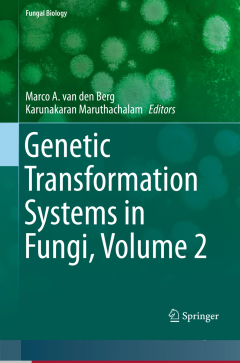
Genetic Transformation Systems in Fungi, Volume 2
Fungi are an economic very important class of microbes. Not only do they host a range of versatile enzymes used in industrial applications (biofuels, laundry, food processing), as well do they produce several very important pharmaceutical drugs (statins and penicillins). Moreover, fungal pathogens can cause great damage in agricultural production (Phytophthora and Botrytis) and during mammalian…
- Edition
- -
- ISBN/ISSN
- 978-3-319-10502-4
- Collation
- XIV, 270
- Series Title
- -
- Call Number
- 632.9 Gen
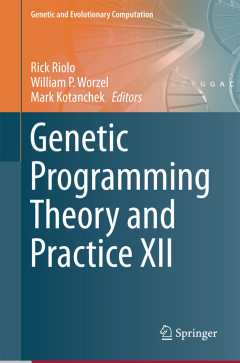
Genetic Programming Theory and Practice XII
These contributions, written by the foremost international researchers and practitioners of Genetic Programming (GP), explore the synergy between theoretical and empirical results on real-world problems, producing a comprehensive view of the state of the art in GP. Topics in this volume include: gene expression regulation, novel genetic models for glaucoma, inheritable epigenetics, combinators …
- Edition
- -
- ISBN/ISSN
- 978-3-319-16029-0
- Collation
- XII, 182
- Series Title
- -
- Call Number
- 005.1 Gen
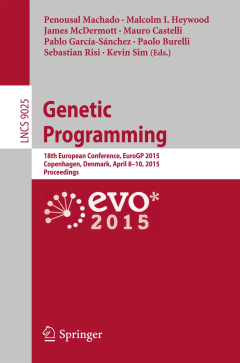
Genetic Programming
This book constitutes the refereed proceedings of the 18th European Conference on Genetic Programming, EuroGP 2015, held in Copenhagen, Spain, in April 2015 co-located with the Evo 2015 events, EvoCOP, Evo MUSART and Evo Applications. The 12 revised full papers presented together with 6 poster papers were carefully reviewed and selected form 36 submissions. The wide range of topics in this volu…
- Edition
- -
- ISBN/ISSN
- 978-3-319-16500-4
- Collation
- -
- Series Title
- -
- Call Number
- 005,1 Gen

Genetic Manipulation in Plants for Mitigation of Climate Change
This book presents a detailed overview and critical evaluation of the state of the art and latest approaches in genetic manipulation studies on plants to mitigate the impact of climate change on growth and productivity. Each chapter has been written by experts in plant-stress biology and highlights the involvement of a variety of genes/pathways and their regulation in abiotic stress, recent adv…
- Edition
- -
- ISBN/ISSN
- 978-81-322-2660-4
- Collation
- 3 b/w illustrations, 15 illustrations in colour
- Series Title
- -
- Call Number
- 630 Gen
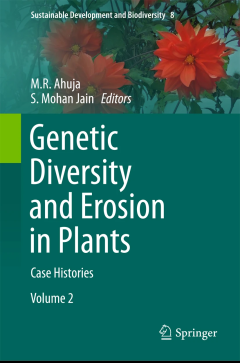
Genetic Diversity and Erosion in Plants
Genetic erosion is the loss of genetic diversity within a species. It can happen very quickly, due to catastrophic events, or changes in land use leading to habitat loss. But it can also occur more gradually and remain unnoticed for a long time. One of the main causes of genetic erosion is the replacement of local varieties by modern varieties. Other causes include environmental degradation, ur…
- Edition
- editor M.R. Ahuja,
- ISBN/ISSN
- 978-3-319-25953-6
- Collation
- VIII, 438
- Series Title
- -
- Call Number
- 630 g
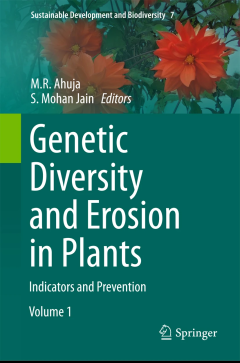
Genetic Diversity and Erosion in Plants
Genetic erosion is the loss of genetic diversity within a species. It can happen very quickly, due to catastrophic events, or changes in land use leading to habitat loss. But it can also occur more gradually and remain unnoticed for a long time. One of the main causes of genetic erosion is the replacement of local varieties by modern varieties. Other causes include environmental degradation, ur…
- Edition
- -
- ISBN/ISSN
- 978-3-319-25635-1
- Collation
- X, 323
- Series Title
- -
- Call Number
- 630
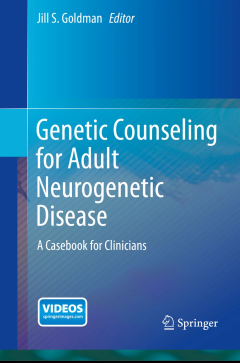
Genetic Counseling for Adult Neurogenetic Disease
The adult patient diagnosed with or at risk for a neurogenetic disease has many questions and concerns for the genetic counselor, the neurologist, and other practitioners. Because of the emotional and potentially life-altering impact of these diseases on the patient and family, counseling can be especially challenging. A rare hands-on guide to the subject, Genetic Counseling for Adult Neurog…
- Edition
- -
- ISBN/ISSN
- 978-1-4899-7481-5
- Collation
- 20 b/w illustrations
- Series Title
- -
- Call Number
- 611 Gen
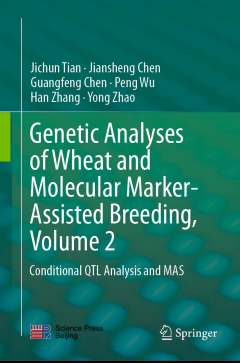
Genetic Analyses of Wheat and Molecular Marker-Assisted Breeding, Volume 2
While focusing on various interactions between trait genes/QTL and dynamic expressions of conditional QTL genes, this book also discusses aspects of molecular marker-assisted breeding, and applications of molecular markers associated with yield, quality, physiology and disease resistance in wheat. It covers QTL studies in wheat breeding and presents the available information on wheat MAS breedi…
- Edition
- -
- ISBN/ISSN
- 978-94-017-7445-1
- Collation
- -
- Series Title
- -
- Call Number
- 631 TJA g

International Perspectives on Designing Professional Practice Doctorates: App…
Today we are living in a world that socially, politically, culturally, and economically changes faster than ever before. Uncertainty and unpredictability now present some of the biggest challenges to organizations. There was never a greater need for us all to have the ability to disenthrall ourselves, to think anew and act anew, yet our educational systems have not changed quickly enough i…
- Edition
- -
- ISBN/ISSN
- 978-1-137-52705-9
- Collation
- -
- Series Title
- -
- Call Number
- -

International Mobility and Educational Desire: Chinese Foreign Talent Student…
This work is subject to copyright. All rights are solely and exclusively licensed by the Publisher, whether the whole or part of the material is concerned, specifi cally the rights of translation, reprinting, reuse of illustrations, recitation, broadcasting, reproduction on microfi lms or in any other physical way, and transmission or information storage and retrieval, electronic adaptation…
- Edition
- -
- ISBN/ISSN
- 978-1-137-59143-2
- Collation
- -
- Series Title
- -
- Call Number
- -
 Computer Science, Information & General Works
Computer Science, Information & General Works  Philosophy & Psychology
Philosophy & Psychology  Religion
Religion  Social Sciences
Social Sciences  Language
Language  Pure Science
Pure Science  Applied Sciences
Applied Sciences  Art & Recreation
Art & Recreation  Literature
Literature  History & Geography
History & Geography